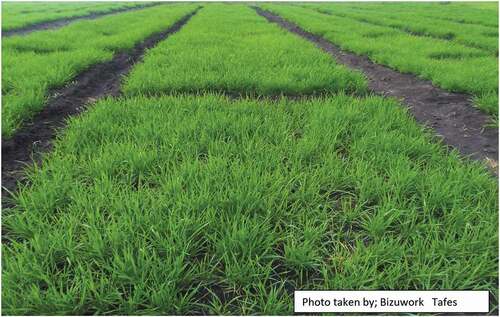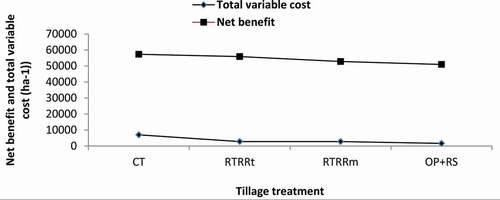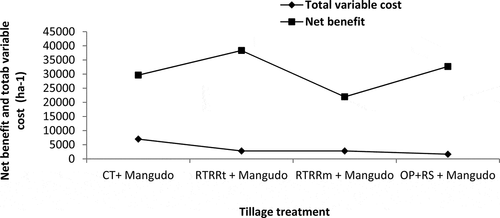Abstract
Frequent tillage and removal of crop residue from arable land after harvest is increasing soil runoff, reduce in situ soil moisture and soil fertility as a result decrease crop yield. Conservation tillage is a technique that can mitigate these situations and thereby increases crop yield. Therefore, the investigation was carried out on a farmer’s field at Memrhager and Aelmetena. The objective of the present investigation is to evaluate the impacts of conservation tillage on the productivity of durum wheat. The experimental layout was arranged to a randomized complete block design with three replications. The treatments included conventional tillage which was plowed five times and three different conservation tillage techniques (reduce tillage residue retained, reduce tillage residue removed, and one plow at sowing with roundup spray and two durum wheat (Mangudo and Ude) cultivars). Conservation tillage was a significant increase in grain yield of durum wheat at Alemtena. Grain yield was 43.6% more under reducing tillage residue retained combined with Mangudo variety compared with reduced tillage residue removed, probably due to improving the infiltration of water into the soil and reducing water loss by direct evaporation under this tillage system. The grain yield was 23.1% more under conventional tillage compared with one plow at sowing + roundup at Memrhager. On the economic analysis, completely the highest net benefit (38349.9 ETBirr/ha) was obtained under reducing tillage residue retained at Alemtena but comparable net benefit at Memrhager. In summary, conservation tillage (reduce tillage residue retained) more important in soil moisture deficit area.
PUBLIC INTEREST STATEMENT
Major theme of research is in improving the level of productivity and long-term sustainability of agricultural land and ecosystems. This includes research in field crop management, planning, monitoring and assessment, as well as crop improvement and restoration. Major areas of investigation include the integrated control and management of field crops using proper agronomic management activities, work on establishing guidelines for applying improved technologies, and research into the ecology and management systems. In the future, my research program is focused on technologies that reduce the need for synthetic nitrogen fertilizers to grow crops by replacing them with more natural, biological resources. I employ both basic and applied research in my research program.
1. Introduction
In Ethiopia, durum wheat is produced by smallholder farmers in the highlands, where the environmental characteristics range from low to high temperature. The crop is planted late in the growing season to avoid early waterlogging, and it continues to grow during the dry period on residual moisture at altitudes between 1800 and 2800 m.a.s.l. (Negassa et al., Citation2013). Durum wheat production by smallholder farmers in the highland of Ethiopia is involved in conventional tillage with an oxen-drawn plow traditionally known as a “Maresha” (Jens et al., Citation2001). Conventional tillage (CT) refers to the intensive tillage with multiple passes of equipment to accomplish soil preparation for seed sowing (Bartaula et al., Citation2019). There are several good reasons for tilling the soil: it incorporates weeds, fertilizers, and manure added to the soil, and previous crop residues; allows preparation of a seedbed to facilitate seed placement at proper depth for uniform germination; helps aerate the soil (Hobbs, Citation2007).
However, it is well established that there can be negative impacts of frequent tillage practices (Bartaula et al., Citation2019). Frequent soil tillage increases the loss of soil organic matter because of the mixing of soil and crop residues the disruption of aggregates, and increased aeration (Hernanz et al., Citation2002), increases run-off, wind erosion, reduced vegetative cover, and reduced water infiltration (Hobbs, Citation2007); change in soil structure by modifying soil bulk density and soil moisture content (Bartaula et al., Citation2019). Soil erosion losses due to repeated tillage, in Ethiopia, have been estimated to be 1.5 billion tons per year which 45% from the arable land (Bewket & Teferi, Citation2009; Gelagay & Minale, Citation2016). Soil degradation caused by frequent tillage and removal of crop residue from the cropland after harvest is associated with increased occurrence of soil water deficits (Edao, Citation2015; FAO, Citation2010; Taddese, Citation2001).
In order to reverse this devastating situation, increased emphasis should be given to integrated approaches for sustainable agricultural development. Recent agricultural research has resulted in innovations that enable farmers to increase their yields and protection of natural resources. One of these innovations is conservation tillage. Conservation tillage favors timely sowing of crops, minimizes labor cost, improves soil aggregate stability, and protects the environment on a long-term basis (Alvaro, 2014). It is also reversed soil degradation and increased soil water availability, particularly in soil moisture deficient areas (Alvaro et al., Citation2014). Comparing CT tillage with conservation agriculture (CA), Bartaula et al. (Citation2019), Roth et al. (Citation1988) and Tarkowska et al. (Citation2018) found that higher infiltration rates and more available soil water with CA, especially during critical crop development stages, resulted in higher grain yield of wheat.
Although few past research efforts indicated encouraging results in different parts of the country, the research efforts were limited only to the effects of CA (reduced and zero-tillage) on the productivity (grain and biomass yield) of maize (Bisrat et al., Citation2015; Liben et al., Citation2017) Sorghum (Tewodrose et al., Citation2005) and tef (Oicha et al., Citation2010; Gebreyesus, Citation2014; Gezahegn et al., Citation2019) crops as compared to the conventional tillage practices. However, the effect of conservation tillage practice on durum wheat is not well documented. We hypothesize that conservation tillage combined with improved variety is a means to improve durum wheat productivity by improving soil water availability reduced soil losses and rainfall productivity. Therefore, the objective of this study was to compare different conservation tillage with conventional tillage (traditional tillage) to improve soil moisture, reduce soil loss, and increase productivity.
2. Materials and methods
The experiment was conducted on a farmer’s field under rain-fed conditions at Memrhager and Alemtena for three consecutive years from 2015 to 2017. Memrhager has a high potential for durum wheat production and is located at 8°46´33.5˝ N and 39°16´40.7˝ E with 2257.7 meter elevation. The soil order was Vertisol. Soil texture, mean soil bulk density, and soil organic matter for the 0–0.2 m soil layer were clay loam, 52 g kg−1 clay, 1.23 g cm−3, and 196 g kg−1, respectively. Rainfall was well distributed over the crop growing season in 2015 with 612 mm, in 2016 with 635 mm, and in 2017 with 647 at Memrhager ().
Figure 1. Precipitation (mm/10 days) of during durum wheat growing season in 2015, 2016 and 2017 at Memerhager
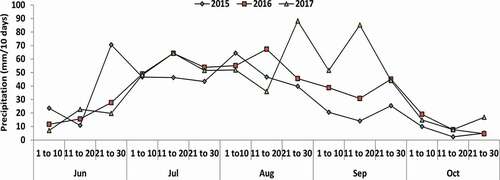
Alemtena has a low potential for durum wheat production and is located at 8°30 ´57.6˝ N and 39° 95´10.6˝ E with 1611 meter elevation. The soil order was Andisols (Typic Haplustand) with low wet aggregate stability, a propensity for crusting (Mesfin et al., Citation2014), and its vernacular name is “Gonbore” meaning gray soils (Liben et al., Citation2017). Soil texture, mean soil bulk density, and soil organic matter for the 0–0.2 m soil layer was silt loam (28 g kg−1 clay), 1.21 g cm−3, and 10 g kg−1. Seasonal rainfall at Alemtena was 498 mm in 2015, 547 mm in 2016, and 617 mm in 2017 (). There was low rainfall during durum wheat grain fill (starting from the day flowering to maturity) in 2015 compared to two consecutive years at this location (). The area can be described as transitional between semiarid to sub-humid. Rainfall has a weak bi-modal pattern and includes 175 to 358 mm in March–April and 420 to 680 mm in June to September (Kassie et al., Citation2013) but the rainfall is erratic and periods of severe soil water deficits often occur (Kassie et al., Citation2013; Liben et al., Citation2015; Tesfaye et al., Citation2015). Generally, rainfall received in the three between planting to physiological maturity was relatively low.
Figure 2. Precipitation (mm/10 days) of during durum wheat growing season in 2015, 2016 and 2017 at Alemtena

2.1. Experimental design and field management
The treatments consisted of two durum wheat varieties (Mangudo and Ude) and four tillage systems conventional tillage (CT), reduced tillage residue retained (RTRRt), reduced tillage residue removed (RTRRm), and one plow at sowing + roundup spray (OP+RS). A total of 16 treatment combinations were considered. The experiment was laid out in a randomized complete block design (RCBD) in a factorial arrangement replicated three times per treatment. With, conventional tillage the soil was tilled five times at 15 to 20 cm depth using the oxen-drawn “Marsha” after >90% of crop residue was grazed or removed while the remaining stubble incorporated. In reduced tillage with residue retained (RTRRt) treatment, plots were tilled two times with 30% of crop residue retained from the previous harvest while in the reduced tillage residue removed (RTRRm) treatment crop residue was removed followed plots were tilled two times according to the local practice of tilling soil using the oxen-drawn “Maresha”. One plow at sowing+ roundup spray (OP+RS) tillage plots were kept intact fallow until they were sprayed with the non-selective herbicide glyphosate (N-(phosphono-methyl) glycine) at 1 L ha−1 20 days, and then, plots were open with a single and slight plow before sowing.
The net plot area was 20 m2 at both sites. The distances between the plot and the block were kept at 1 m and 1.5 m, respectively. Each plot consisted of 20 rows spaced 20 cm apart. The net central unit areas of each plot consisting of eight central rows of 4.80 m long and 1.60 m (7.68 m2) were harvested and used for yield determination. The two outermost rows were kept as border plants. Fertilizer application included 100 kg/ha di-ammonium phosphate (18% N and 46% P2O5) the band applied at planting for both sites and 100 kg/ha Urea (46% N) split application 1/3 at planting and 2/3 at the tillering stage of the crop at Memrhager and Alemtena, respectively. The seed of variety Ude and Mangudo was collected from DZARC and sown with hand drilling at the rate of 150 (kg/ha) in 20 cm rows space on 27 July 2015, on 25 July 2016 and on 28 July 2017 at Memrhager and on the 14th of July 2015, on 15th of 2016 and on 13th 2017cropping season at Ude. Harvesting was done on 24 November 2015, on 25 November 2016 and on 28 November 2017 at Memrhager and on 14 October 2015, on 16 October 2016, and on 13 October 2017.
2.2. Measurements
Crop growth parameters assessed included the plant phenology and plant height. Days to 50% heading and days to 90% maturity were recorded based on visual observation at the plot basis of each site. Plant height, the spike length and the number of seed/spike were recorded randomly taken from 10 plants from middle rows from each plot at the time of harvesting and measured by a ruler from the bottom of the aboveground to the tip of the head for plant height and from the bottom of spike to the tip of the spike with excluding the awns for spike length and then, the mean value was determined in cm. For the number of kernels/spike, the spikes were threshed separately and counted the seed, and then the mean number of kernels per spike was recorded. Productive tillers (effective tillers) were determined at maturity by counting all the productive (head bearing) tillers in one m length row taken from five rows (1 m wide) in each net plot area and then converted to m2. At maturity, the whole aboveground plant parts, including leaves, stems, and seeds from the net plot area (8 rows) in each plot were harvested and oven-dried with 72°C for 24 hours and then the aboveground biomass (AGBY) was weighed and then expressed in kg/ha. Grain yield (GY) from the net plot area of each plot was recorded by measuring the GY and adjusted at 12% seed moisture content. Straw yield per net plot was obtained out by subtracting total grain yield weight from the total biomass yield for respective treatments. Later the straw yields ha-1 were computed and expressed in kg ha-1. Harvest index (HI) refers to the ratio of GY at 12% seed moisture content to the AGBY (seed + grain yield) and it is expressed in percentage. A thousand kernels were counted by an electronic counter and weighed by the electronic balance later thousand kernels weight was expressed in gram. The economic advantages of different tillage systems were carried out using partial budget analysis as described by International Maize and Wheat Improvement Center [CIMMYT] (Citation1988). In this experiment, the costs of operation were calculated based on oxen ranted for tillage operation equal to 1400 ETBirr/ha at zero tillage. For chemical (roundup) cost was 250 ET Birr/L. Financial analyses were made by using the sum of costs of implement use, tillage, chemical purchasing cost, and sprayer based on the treatment specification, operations as a total expense, and sales from durum wheat grain at 14.87 ETBirr/kg and straw cost 3.5 ETB/kg.
2.3. Statistical data analysis
ANOVA was used to test statistical differences in the tillage system and varieties. Combined analyses across years were performed using the SAS statistical software while separate analyses were conducted for each location because of heterogeneity of variance error. Data were tested for normality before doing the ANOVA following the General Linear Model (GLM) procedure at the 0.05 probability level. When significant treatment effects occurred, means were compared using LSD 0.05.
3. Result and discussion
3.1. Durum wheat phenology
Durum wheat phenology was affected by the main and interaction effect. Days to heading varied more with year and tillage compared with variety due to slow development in 2017 and OP+RS system compared with other years and tillage system at both Memrhager and Alemtena.
Days to heading, in 2015 were prolonged by 5% and 3% compared with 2017 and 2016 year, respectively at Memrhager. However, at Alemtena days to heading was prolonged by 6% in 2016 compared with the other years (). This might be due to the inconsistent precipitation and its minimum rain in the years during the grain filling period (). Tillage practice affected the days to flowering at both sites. The longer days to heading were recorded under the conservation tillage system at Memrhager but at Alemtena, days to heading were prolonged by RTRRt practice compared with others tillage. Extended days to heading in RTRRt may be due to better water utilization by this system under RTRRt, which was indicated prolonged days to heading. Extended flowering and maturity of crops under conservation tillage were because of better soil water availability under conservation tillage (Liben et al., Citation2018; Naudin et al., Citation2010).
Table 1. The effects of tillage practices and variety on durum wheat phenology and growth traits at Memerhager and Alemtena from 2015 to 2017
Considering the days to maturity, tillage system x variety interaction was the significant effect at both locations when days to maturity was 6.1% more with RTRRt with Ude variety interaction at Memrhager (). At Alemtena, days to maturity were 7.7% more with RTRRt treatment (). The soil at Memrhager has been observed to have a wet aggregate stability and to be prone to water infiltration and possibly due to more soil water availability with conservation tillage might have been prolonged crop maturity while in the OP+RS treatment soil was compacted and less water infiltration may have hasted the physiological maturity of durum wheat. Similarly, with earlier crop phenology with reduced-tillage reported previously (Liben et al., Citation2017) crop phenology was earlier with conservation tillage compared with conventional (repeated) tillage.
Figure 3. Interaction effects of tillage and variety on durum wheat maturity at Memerhager, Ethiopia. Abbreviations: CT, conservation tillage (5 times pass), RTRRt: reduced tillage residue retained, RTRRm: reduced tillage residue removed, OP+RS, one plow +round up spray in 2015, 2016 and 2017 cropping season
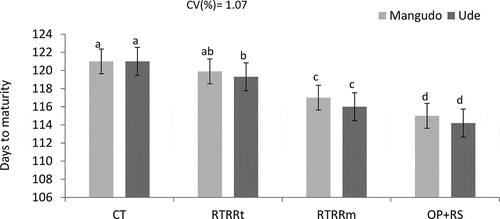
Figure 4. Interaction effects of tillage and variety on durum wheat maturity at Alemtena, Ethiopia. Abbreviations: CT, conservation tillage (5 times pass), RTRRt: reduced tillage residue retained, RTRRm: reduced tillage residue removed, OP+RS, one plow +round up spray in 2015, 2016 and 2017 cropping season

At Alemtena, RTRRt has prolonged the crop maturity compared to RTRRm tillage agrees with other findings (Liben et al., Citation2017; Naudin et al., Citation2010). This might be due to more soil water availability and less water evaporation under this tillage system cumulatively delayed crop maturity. The soil moisture effect was likely less with crop residue cover of the soil and improved surface soil water conservation (Liben et al., Citation2018) but more frequent occurrence of soil water deficits due to less water infiltration and more water evaporation soil exposed to without crop residue cover may have hastened maturity period (Lal, Citation1988; Mando et al., Citation1999).
3.2. Yield components
The number of productive tillers (NPT) and the number of kernel per spikes (NKPS) were affected by year and variety at Memrhager (). At Alemtena, NPT was affected by year and tillage treatments but NKPS was affected by variety and tillage system. The effect of the tillage system did not have a significant effect on the NPT and NKPS at Memrhager. At Alemtena, year on the NKPS and variety on the NPT was no statistically significant effect. Interaction effects of variety × tillage, as well as year x variety x tillage treatment, were not significant on the NPT and NKPS at both locations.
Table 2. The effects of tillage practices and variety on durum wheat number of productive tillers (NPT), kernel per spike (NKPS) and spike length (SL) at Memerhager and Alemtena from 2015 to 2017
Table 3. The effects of tillage practices and variety on harvest index and thousand kernel weight of durum wheat at Memerhager and Alemtena from 2015 to 2017
Results demonstrated a significant effect of year on NPTP at Memrhager. The highest NPT was recorded in 2015 compared to 2016 but no differences in 2017 (). At Alemtena, NPT was more in 2017 compared to 2015 and 2016. This might be due to better and sufficient precipitation during the grain filling period (September) in 2017 compared with other years ().
There was a significant effect of variety on the NPT and NKPS at Memerehager. At Alemtena, the variety was significant effects observed only NKSP. At both locations, the highest NPT was obtained from Mangudo variety and the lowest was obtained from Ude variety. Both at Memrhager and Alemtena NKPS were also more in Mangudo compared with Ude. This difference comes from the genetic make-up of the cultivars. In Ethiopia, others reported (Gezahegn et al., Citation2019).
The effect of the tillage system was significant on NPT and NKPS at Alemtena but not at Memrhager. In RTRRt treatment, NPT and NKPS were 18% and 16% more, respectively, compared with RTRRm in agreement with (Gezahegn et al., Citation2019; Liben et al., Citation2018; Tewodrose et al., Citation2005). The highest NPT and NKPS under RTRRt may be due to better water utilization by this system under RTRRt, which were indicated better yield components. More soil water with conservation tillage in the 0–0.05 m soil profile, reduced evaporation by crop residue cover (Derpsch, Citation2008; Thierfelder & Wall, 2009). At Memerehager, indicating conservation tillage may not be beneficial for improving the mentioned traits; it that more time may be required to achieve conservation tillage benefits for this soil because the soil at this site was wet aggregate stability and high clay contents.
Spike length was significantly affected year by variety interaction (), but tillage system, variety, and tillage by variety interaction were not significant effect at Memrhager. At Alemtena, the trait was affected only by year but variety, tillage system, and tillage by variety interaction did not have a significant effect (). The overall mean spike length was 6.5 cm was obtained variety Ude in 2016 cropping year and the shortest spike length was in 2015 () due to slow development in 2015. This could be insufficient rainfall, particularly crop growth time (). However, even though there were tillage systems and the interaction effects of tillage by variety, there was no effect on spike length at both locations. Therefore, there is no evidence of a synergistic report.
Figure 5. Interaction effects of year and variety on durum wheat spike length at Memerhager, Ethiopia. Abbreviations: CT, conservation tillage (5 times pass), RTRRt: reduced tillage residue retained, RTRRm: reduced tillage residue removed, OP+RS, one plow +round up spray in 2015, 2016 and 2017 cropping season
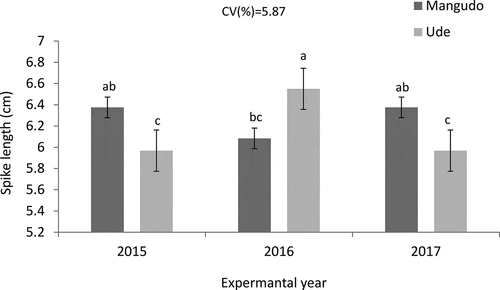
3.3. Harvest index and thousand kernels weight
Both HI and TKW were not significantly affected by year, variety, and tillage except HI by year and TKW by variety at Memrhager (). At Alemtena, also did not have a significant effect between the year, variety, and tillage system on the above-mentioned traits (). The interaction effect between tillage by variety was not significant at both sites.
The highest HI and TKW were recorded in the 2016 experimental year and Mangudo variety, respectively at Memrhager (). The greater HI in 2016 at Memrhager could be because of more biomass accumulation and better sink to source relation of durum wheat due to sufficient precipitation throughout crop growing in 2016 compared with other years supported by . Although statistical were not significant, but numerically the highest HI and TKW were observed under RTRRt at both locations (). From the current investigation, the tillage system was a little sign on the HI and TKW. This could be due to TKW was more governed by genetics.
3.4. Biomass and straw yield
Variation in durum wheat dry biomass and straw yield, between treatments and seasons, was illustrated (). The dry biomass and straw yield was significantly affected by the year at Memrhager. At Alemtena, the effect of year was significant on the biomass yield but did not have a significant effect on the straw yield. Both biomass and straw yield was 38% and 71%, respectively, more in 2016 compared within 2015 at Memrhager. But at Alemtena, 36.8% more biomass yield was in 2017 compared to 2015 but did no significant difference in the 2016 season. The year differences in biomass and straw yield of durum wheat were probably due to the inconsistency in precipitation and its distribution in 2015 (). There was an El Niño event in 2015 in Ethiopia, and these events led to crop damage (BFS/USAID, Citation2017).
Table 4. The effect of tillage practices and variety on biomass, grain and straw yield of durum wheat at Memerhager and Alemtena from 2015 to 2017
The wheat biomass and straw yield were significantly affected by the tillage system at both locations. At both sites, the effect of variety on the biomass, and straw yield was not significant. The interaction between tillage systems and variety was also not a significant effect on biomass, and straw at both sites.
The significantly higher (15.8%) biomass and (13.1%) straw yield at Memerhagesr and 34.7% biomass and 52.3% straw yield at Alemtena was obtained under conservation tillage treatment. But the mean differences between conservation tillage and RTRRt were not significant at both sites. In contrast, OP+RS treatment resulted in lower biomass and straw yield than the rest of the tillage systems at both Memrhager and Alemtena. This result is in proximity to that of Habtegebrial et al. (Citation2007) and Gezahegn et al. (Citation2019). The positive effect of RTRRt on biomass and straw yield may have maintained more water in the soil porosity by reducing evaporation from the soil surface, which is explained by the effect of the crop residue left on the soil surface, an increase in organic matter, and an improvement of the physical properties of the soil (Oicha et al., Citation2010; Gezahegn et al., Citation2019; Shaver et al., Citation2002) cumulatively increases biomass and straw yield compared with RTRRm and OP+RS.
3.5. Grain yield
Results of grain yield analysis indicated a significant difference between tillage treatments () and tillage by a variety of interactions () at Memrhager and Alemtena, respectively. The yield was higher by 23.1% and 12.2% under conservation tillage and RTRRt, respectively, compared to OP+RS at Memrhager (). As mean values, the grain yield under conservation tillage and RTRRt was almost similar at Memrhager. The same behavior was also found for the biomass and straw yield since no significant variation in mean values between conservation tillage and RTRRt treatments was observed. The lack of significant differences between CT and RTRRt for grain yield would confirm that the soil at Memrhager has been observed to strong wet aggregate stability, soil with wet aggregate stability has improved water infiltration and reduced evaporation (Liben, 2017). On the other hand, the wheat yield was decreased under OP+RS, which might be due to compaction of soil under this tillage system, negatively affect the growth of deep roots leading to less water and nutrients absorption from the deeper horizon of the soil (Alvarez & Steinbach, Citation2009). Our results agree with the finding by Hammel (Citation1995), Feng et al. (Citation2018) and Gezahegn et al. (Citation2019) found that no-tillage/minimum tillage significantly decreased wheat grain yield compared to reduced and conventional tillage.
Figure 6. Interaction effects of tillage practices and variety on the grain yield of durum wheat at Alemtena, Ethiopia. Abbreviations: CT, conservation tillage (5 times pass), RTRRt: reduced tillage residue retained, RTRRm: reduced tillage residue removed, OP+RS, one plow +round up spray in 2015, 2016 and 2017 cropping season
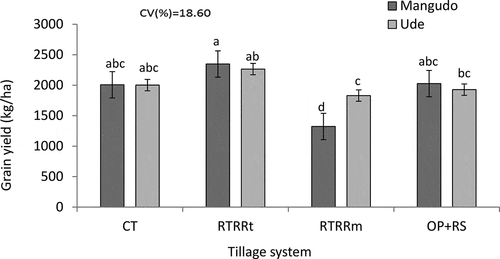
At Alemtena, there was a significant difference in the tillage system by variety of interaction on the grain yield of durum wheat (). Although there was a significant difference in yield between RTRRm, no difference in yield was observed between OP+RS and Mangudo variety. Grain yield was significantly more by 43.6% under RTRRt combined with Mangudo variety compared with RTRRm. Probably improving the infiltration of water into the soil and reducing water loss by direct evaporation under this tillage system and genetically make-up of the cultivar likely contributed to the higher yield under these treatment combinations, because the soil at Alemtena has been observed to have weak wet aggregate stability and to be prone to the frequent occurrence of soil water deficits. Earlier studies reported that reduced tillage with crop residue left on the soil surface, producing less evaporation, an increase in organic matter, and improvement of the physical properties of the soil (Liben et al., Citation2017; Merga et al., Citation2014). This result is in agreement with Tesfay et al. (Citation2011), Gebreyesus (Citation2014), and Gezahegn et al. (Citation2019) reported that reduced tillage with residue retained had a significant effect on soil fertility improvement, moisture conservation, and increased crop yield. In general, in our investigation, the effect of conservation tillage tended to be greater than in soil moisture deficit area compared with conventional tillage, while in the humid soil in vice versa.
3.6. Financial analysis
Partial budget analysis results are presented in at Memrhager and Alemtena, respectively. Although the net benefit was greatest in the conservation tillage system (57313.2 ha−1), the highest net benefit (55872.1 ha−1) was also obtained in the RTRRt treatment at Memrhager. At Alemtena, completely the highest net benefit (38349.9 ha−1) was obtained under RTRRt. This implies that the yield produced by the RTRRt tillage operation completely covered the total cost. The lowest net benefit (219144.3 ha−1) was recorded in one pass of sowing. Therefore, on economic grounds, RTRRt (two times plowing) at AlemTena and Minjar would be an alternative tillage system for the productivity of durum wheat.
3.7. Farmer’s perceptions
The group discussions with farmers revealed that many farmers, particularly women were preferred with RTRRt over conventional tillage those who have a sharing of oxen. Moreover, men farmers also choose this tillage system. Farmers realize that oxen sharing would be eased and reduced the cost of ox rent if they reduced to two times from five times plowing. In other words, farmers who have to borrow oxen from others have to plow avoid competition for oxen. In addition, the economic advantage, in the discussions with farmers revealed that if insufficient rainfall is received in March and April, more farmers start tillage in dry plowing. Soils are hard to plow when they are dry while oxen are weak in reputedly tilled during the dry season. Dry plowing forms too many clods that are difficult to break later thus resulting in poor seedling emergence (poor seed-soil contact). It is also interesting to farmers in reduced tillage, particularly at Alemtena, it minimizes soil evaporation (local name Nishi) and increases the infiltration rate. Conservation tillage systems save labor and traction needs without yield penalty.
4. Conclusion
The present investigation showed RTRRt (two times plowing) tillage practices can produce a higher and comparable yield advantage compared with CT practices (farmer practices) at Alemtena and Memrehager, respectively. The tillage practice was also attractive to farmers if production costs are sufficiently less in RTRRt compared with CT. However, RTRRm and OP+RS practices were not found to be suitable in all production situations. It can be concluded that RTRRt tillage systems can perform greatly, with increasing crop yields and often at lower tillage time, than CT. Therefore, in the study areas, farmers will not spend time for successive tillage operations; if they utilize reduced tillage, which requires less plowing time.
Acknowledgements
The institutional support of the Ethiopia Institute of Agricultural Research and Debre Zeit Agricultural Research Center and Agricultural growth program phase two (AGPII) were essentials to the completion of this research. It was supported by the Agronomy and Crop Physiology Research Program.
Additional information
Funding
Notes on contributors

Bizuwork Tafes Desta
Bizuwork Tafes Desta, Durum wheat production by smallholder farmers in the highland of Ethiopia is involved repeated tillage with an oxen-drawn plow traditionally known as a “Maresha”. Frequent soil tillage increases the loss of soil organic matter, increases runoff, wind erosion, reduced vegetative cover, and reduced water infiltration as a result reduced durum wheat productivity. In order to reverse this devastating situation, increased emphasis should be given to integrated approaches for sustainable agricultural development. Recent agricultural research has resulted in innovations that enable farmers to increase their yields and protection of natural resources. One of these innovations is conservation tillage. The present investigation showed reduce tillage residue retained (two times plowing) tillage practices can produce higher and comparable yield advantage compared with conventional tillage practices (farmer practices) at Alemtena and Memrehager, respectively. This tillage practice was also attractive to farmers if production costs are sufficiently less in conservation tillage compared with conventional tillage.
References
- Alvarez R, Steinbach HS. 2009. A review of the effects of tillage systems on some soil physical properties, water content, nitrate availability and crops yield in the Argentine Pampas.Soil and Tillage Research.2009 2009 104.02 1.005 doi:https://doi.org/10.1016/j.still.2009.02.005
- Alvaro, F. J., Plaza, B. D., Arrúe, J. L., & Cantero, M. C. (2014). Soil organic carbon storage in a no-tillage chronosequence under Mediterranean conditions. Plant and Soil, 376(1–2), 31–15. https://doi.org/https://doi.org/10.1007/s11104-012-1167-x.
- Bartaula, S., Panthi, U., Adhikari, A., Mahato, M., Joshi, D., & Aryal, K. (2019). Effect of different tillage practices and nitrogen level on wheat production under inner terai of Nepal. Journal of Agriculture and Natural Resources, 3(1), 233–239. https://doi.org/https://doi.org/10.3126/janr.v3i1.27177
- Bewket, W., & Teferi, E. (2009). Assessment of soil erosion hazard and prioritization for treatment at the watershed level: Case study in the Chemoga watershed, Blue Nile basin, Ethiopia. Land Degradation & Development, 20(6), 609–622. https://doi.org/https://doi.org/10.1002/ldr.944
- BFS/USAID. (2017). Climate-smart agriculture in Ethiopia. CSA country profiles for Africa series.
- Bisrat, G., Laike, K., & Hae, K. (2015). Evaluation of conservation tillage techniques for maize production in the central rift valley of Ethiopia. Ethiopian Journal of Agricultural Science, 25(2), 47–58.
- Derpsch, R. (2008). No-tillage and conservation agriculture. In T. Goddard, M. Zoebisch, Y. Gan, W. Ellis, A. Watson, & P. S. Sombat (Eds.), No-till farming systems ( Spec. Pub. 3., pp. 432–448). World Association of Soil Water Conservation. https://doi.org/https://doi.org/10.3126/janr.v3i1.27177
- Edao, A. L. 2015. Climate characterization and modeling the impact of climate change on production of maize (Zea mays L.) under different conservation tillage practices in central rift valley of Ethiopia. M.Sc. thesis. Haramaya University.
- FAO. (2010). What is conservation agriculture? Africa Union New Partnership for Africa development (NEPAD) and Africa conservation tillage network (ACT). Retrieved October 28, 2010, from http://www.fao.org/ca/1a.html
- Feng, J., Li, F., Zhou, X., Xu, C., Ji, L., Chen, Z., & Fang, F. (2018). Impact of agronomy practices on the effects of reduced tillage systems on CH4 and N2O emissions from agricultural fields: A global meta-analysis. PLoS ONE, 13(5), e0196703. https://doi.org/https://doi.org/10.1371/journal.pone.0196703
- Gebreyesus, B. (2014). Response of yield and yield components of Tef [Eragrostis tef (Zucc.) Trotter] to tillage, nutrient, and weed management practices in Dura area, Northern Ethiopia. Hindawi Publishing Corporation International Scholarly Research Notices. ID. 439718, 9. https://doi.org/https://doi.org/10.1155/2014/439718
- Gelagay, H. S., & Minale, A. S. (2016). Soil loss estimation using GIS and remote sensing techniques: A case of Koga watershed. Northwestern Ethiopia. International Soil Water Conservation and Research, 4, 2095-6339. https://doi.org/https://doi.org/10.1016/j.iswcr.2016.01.002
- Gezahegn, A. M., Desta, B. T., Takel, A., Eshetu, S., & Tejada Moral, M. (2019). Productivity of tef [Eragrostis tef] under conservation tillage practices in central Ethiopia. Cogent Food and Agriculture, 5(1), 1707038. https://doi.org/https://doi.org/10.1080/23311932.2019.1707038
- Habtegebrial, K., Singh, B. R., & Haile, M. (2007). Impact of tillage and nitrogen fertilization on yield, nitrogen use efficiency of tef (Eragrostis tef (Zucc.) Trotter) and soil properties. Soil and Tillage Research, 94(1), 55–63. https://doi.org/https://doi.org/10.1016/j.still.2006.07.002
- Hammel, J. E. (1995). Long‐term tillage and crop rotation effects on winter wheat production in northernIdaho. Agronomy Journal, 87(1), 16–22. https://doi.org/https://doi.org/10.2134/agronj1995.00021962008700010004x
- Hernanz, J. L., L’opez, R., Navarrete, L., & S’anchez-Gir’on, V. (2002). Long-term effects of tillage systems and rotations on soil structural stability and organic carbon stratification in semiarid central Spain. Soil and Tillage Research, 66(2), 129–141. https://doi.org/https://doi.org/10.1016/S0167-1987(02)00021-1
- Hobbs, P. R. (2007). Conservation agriculture: What is it and why is it important for future sustainable food production? Journal of American Soil Agronomy, 145, 127–137.
- International Maize and Wheat Improvement Center (CIMMYT). (1988). From agronomic data to farmer recommendations: An economics training manual (Completely revised ed.). Solely CIMMYT.
- Jens, B. A., Matewos, T. B., Fenta, G. A., & Abyie, A. A. (2001). The oxen ploughing system in Ethiopia: Can it be sustained? Outlook on Agriculture, 30(4), 275–280. https://doi.org/https://doi.org/10.5367/000000001101293779
- Kassie, B. T., Rotter, R. P., Hengsdijk, H., Asseng, S., Van Ittersum, M. K., Kahiluoto, H., & Van Keulen, H. (2013). Climate variability and change in the central rift valley of Ethiopia: Challenges for rain-fed crop production. Journal of Agricultural Science, 1–17. https://doi.org/https://doi.org/10.1017/S0021859612000986
- Lal, R. (1988). Effects of macro-fauna on soil properties in tropical ecosystems. Agriculture, Ecosystems & Environment, 24(1–3), 101–116. https://doi.org/https://doi.org/10.1016/0167-8809(88)90059-X
- Liben, F. M., Hassen, S. J., Weyesa, B. T., Wortmann, C. S., Kim, H. K., Kidane, M. S., Yeda, G. G., & Beshir, B. (2017). Conservation agriculture for maize and bean production in the central rift valley of Ethiopia. Agronomy Journal, 109(6), 1–10. https://doi.org/https://doi.org/10.2134/agronj2017.02.0072
- Liben, F. M., Tadesse, B., Tola, Y. T., Wortmann, C. S., Kim, H. K., & Mupangwa, W. (2018). Conservation agriculture effects on crop productivity and soil properties in Ethiopia. Agronomy Journal, 110(2), 758–767. https://doi.org/https://doi.org/10.2134/agronj2017.07.0384
- Liben, F. M., Wortmann, C. S., & Tesfaye, K. (2015). Dry soil planting of maize for variable onset of rainfall in Ethiopia. Agronomy Journal, 107(4), 1618–1625. https://doi.org/https://doi.org/10.2134/agronj14.0621
- Mando, A., Brussaard, L., & Stroosnijder, L. (1999). Termite and mulch mediated rehabilitation of vegetation on crusted soil in West Africa. Restoration Ecology, 7(1), 33–41. https://doi.org/https://doi.org/10.1046/j.1526-100X.1999.07104.x
- Merga, F., Tesfaye, K., & Wortmann, C. S. (2014). Dry soil planting of sorghum for vertisols of Ethiopia. Agronomy Journal, 106(2), 469–474. https://doi.org/https://doi.org/10.2134/agronj2013.0472
- Mesfin, T., Mohammed, J., Taklete, A., Merga, F., & Wortmann, C. S. (2014). Skip-row planting of maize and sorghum production in semi-arid Ethiopia. African Journal of Plant Science, 8(3), 140–146. https://doi.org/https://doi.org/10.5897/AJPS2013.1137
- Naudin, K., Goze, E., Balarabe, O., Giller, K. E., & Scopel, E. (2010). Impact of no tillage and mulching practices on cotton production in North Cameroon: A multi-location on farm assessment. Soil and Tillage Research, 108(1–2), 68–76. https://doi.org/https://doi.org/10.1016/j.still.2010.03.002
- Negassa, A., Shiferaw, B., Koo, J., Sonder, K., Smale, M., Braun, H. J., Gbegbelegbe, S., Guo, Z., Hodson, D., Wood, S., Payne, T., & Abeyo, B. (2013). The potential for wheat production in Africa: Analysis of biophysical suitability and economic profitability. CIMMYT IFPRI.
- Oicha, T., Cornelis, W. M., Verplancke, H., Nyssen, J., Govaerts, B., Behailu, M., Haile, M., & Jozef Deckers, G. (2010). Short-term effects of conservation agriculture on Vertisols under tef (Eragrostis tef (Zucc.) Trotter) in the northern Ethiopian highlands. Soil and Tillage Research, 106(2), 294–302. https://doi.org/https://doi.org/10.1016/j.still.2009.12.004
- Roth, C. H., Meyer, B., Frede, H. G., & Derpsch, R. (1988). Effect of mulch rates and tillage systems on infiltrability and other soil physical properties of an oxisol in Parafla, Brazil. Soil and Tillage Research, 11(1), 81–91. https://doi.org/https://doi.org/10.1016/0167-1987(88)90033-5
- Shaver, T. M., Peterson, G. A., Ahuja, L. R., Westfall, D. G., Sherrod, L. A., & Dunn, G. (2002). Surface soil physical properties after twelve years of dry land no-till management. Soil Science Society of America Journal, 66(4), 1296–1303. https://doi.org/https://doi.org/10.2136/sssaj2002.1296
- Taddese, G. (2001). Land degradation: A challenge to Ethiopia. Environmental Management, 27(6), 815–824. https://doi.org/https://doi.org/10.1007/s002670010190
- Tarkowska, J., Ewa, S., Czyz, A., Anthony, D. R., & Cezary, S. (2018). Effects of reduced and traditional tillage on soil properties and diversity of diatoms under winter wheat. International Agrophysics, 32(3), 403–409. https://doi.org/https://doi.org/10.1515/intag-2017-0016
- Tesfay, A., Cornelis, W. M., Nyssen, J., Govaerts, B., Bauer, H., Tewodros, G., Tigist, O., Raes, D., Sayre, K. D., Mitiku, H., & Deckers, J. (2011). Effects of conservation agriculture on runoff, soil loss and crop yield under rain-fed conditions in Tigray, Northern Ethiopia. Soil Use and Management, 27, 404–414. https://doi.org/https://doi.org/10.1111/j.1475-2743.2011.00347
- Tesfaye KF, Gebegblegbe JE, Cairns B, Shiferaw BM.2015. Maize System under climate change in Sub Saharan Africa. Int. J.n. Clim.change. Start age. Management. 7-247-271. doi:https://doi.org/10.1108/IJCCSM-01-2014-0005
- Tewodrose, M., Girma, A., Abdel, R., & Al-Tawaha, M. (2005). Effect of reduced tillage and crop residue ground cover on yield and water use efficiency of sorghum (Sorghum bicolor (L.) Moench) under semi-arid conditions of Ethiopia. World Journal of Agricultural Science, 1(2), 152–160.
- Thierfelder, C., Cheesman, S., & Rusinamhodzi, L. (2012). A comparative analysis of conservation agriculture systems: Benefits and challenges of rotations and intercropping in Zimbabwe. Field Crops Research, 137, 0378-4290. https://doi.org/https://doi.org/10.1016/j.fcr.2012.08.017

